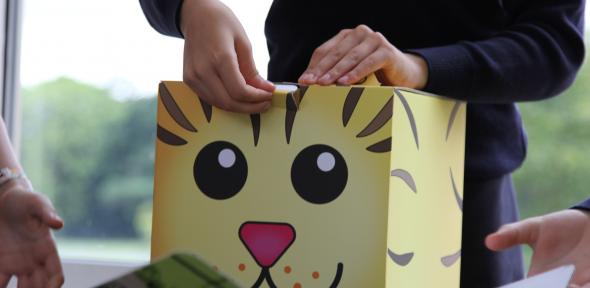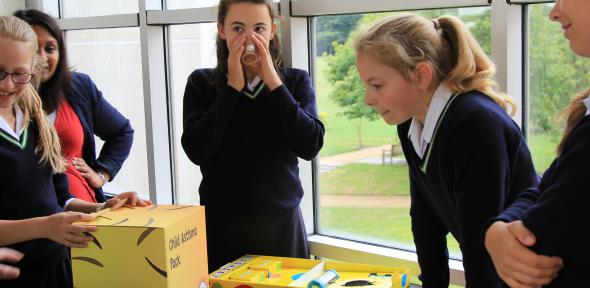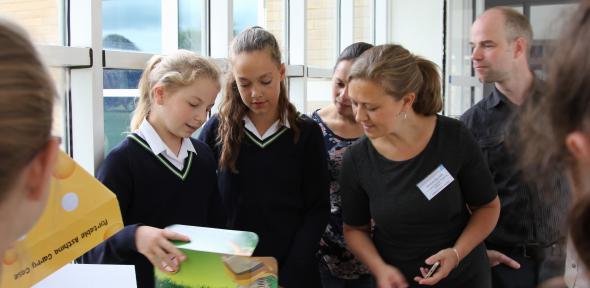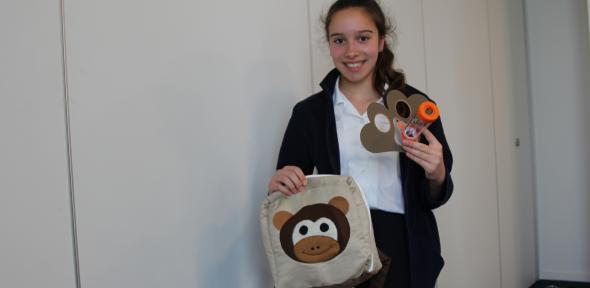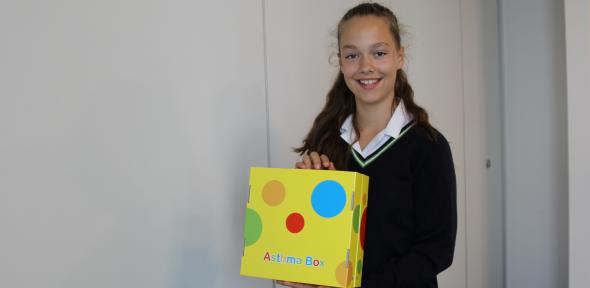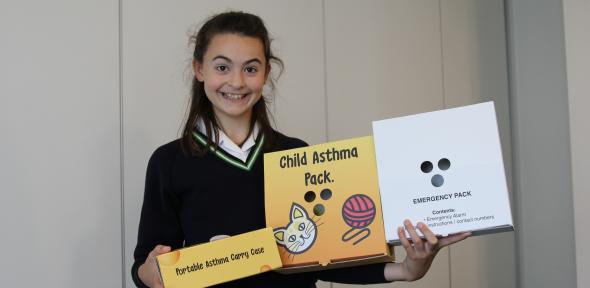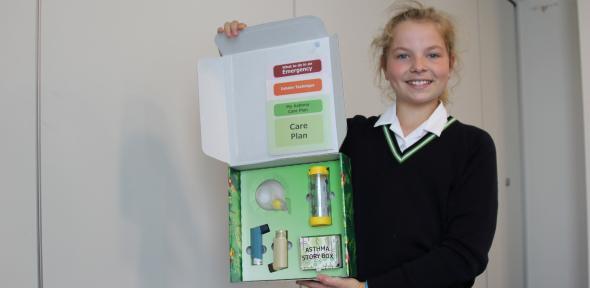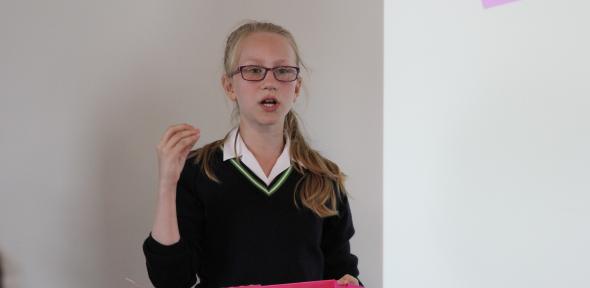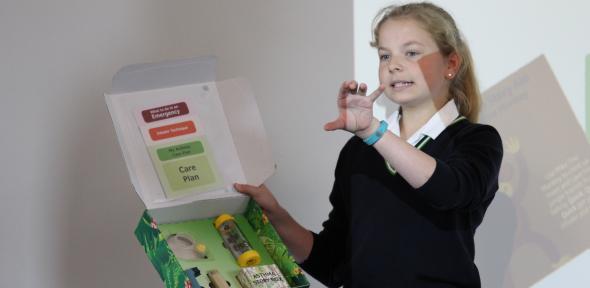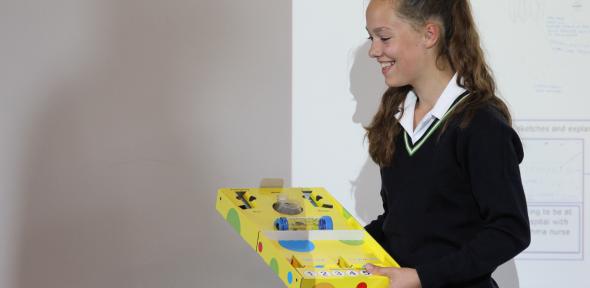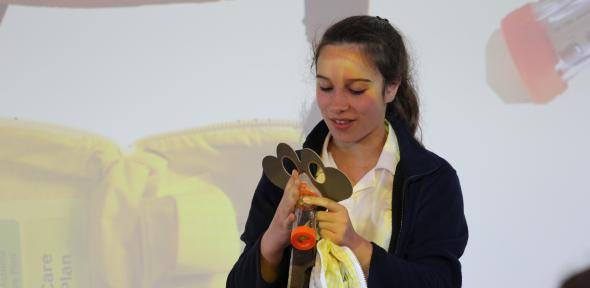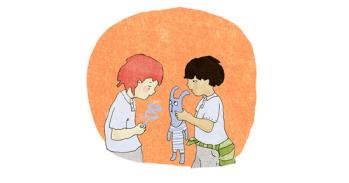
Solutions designed by secondary school students as part of an innovative classroom design and technology programme could help reduce the number of unnecessary deaths from childhood asthma.
Solutions designed by secondary school students as part of an innovative classroom design and technology programme could help reduce the number of unnecessary deaths from childhood asthma.
I feel like I am doing something for a purpose and it makes me feel happy that I am helping people.
Charlotte, aged 11
The programme, called Designing Our Tomorrow, was founded by researchers at the University of Cambridge, and brings real-world problems into classroom design and technology sessions in secondary schools, and encouraging the next generation of UK designers and engineers.
As part of their classroom curriculum, students from different secondary schools have been learning about what makes an effective and useful design. Their goal was to design a type of packaging which would contain everything a young child with asthma would need, whether they’re at home, at school or elsewhere; and one which would help reduce anxiety of children with asthma by using child-friendly design themes. “In other words, we want to make it fun,” said Ian Hosking of Cambridge’s Department of Engineering, who co-leads the Designing Our Tomorrow (DOT) programme, in collaboration with the Faculty of Education. “We want to re-frame what education can be – projects like these start to form a broader evidence base of what’s possible.”
Five of the best designs were presented by students from Wimbledon High School GDST at the British Paediatric Respiratory Society conference last Friday (30 June) in Cambridge.
Students were not merely designing packaging but an experience. Themes included a monkey character where the inhaler and spacer become a banana that the child can ‘feed’ the monkey with and then copy themselves. Other themes include a pack shaped like a cat where the inhalers become mice that are stored in a smaller box shaped like a wedge of cheese; and a folding pack that can hang on a door for easy access at home but can be quickly zipped up and put in a bag to take out.
“Seeing how people were scared of asthma…this affects and could benefit a lot of people. The child wanted it to be fun, the gran wanted emergency instructions, the parents wanted it to be compact and small and the nurse wanted it to be organised – so we took all of that and designed our packs,” said Charlotte, aged 11 from Wimbledon High.
Several of the designs have been made into initial corrugated cardboard prototypes by UK packaging company DS Smith, with the aim of piloting them in partnership with the NHS in London through the Healthy London Partnership.
“It has been great doing something which is able to change and improve children’s lives and help them get better,” said Sascha, aged 12 from Wimbledon High, one of the students who presented her design at the conference. “I am so happy and glad that they have decided to take mine to the next stage and it could appear in people’s homes.”
Asthma affects one in 11 children in the UK. On average, there are three children with asthma in every classroom in the UK, and a child is admitted to hospital every 20 minutes due to an asthma attack.
This DOT project has focused specifically on asthma in children under six years of age. It addresses the anxiety that a child feels in the early stages of treatment and the co-ordination of the equipment and their instructions to help ensure compliance with their treatment plan.
“DOT is a fascinating project which aims to bring real-world problems into classroom design and technology sessions in secondary schools,” said Sara Nelson from the Healthy London Partnership. “It’s one of the more rewarding pieces of work that I have had the pleasure of being involved in during the last year, the one I have learned the most from, and it involved collaborating with an unusual partner for the NHS.”
Each of the students was given all of the tools which a child with asthma or their carer would need to manage their condition, including inhalers, spacers, and emergency instructions. Through a set of classroom lessons, the students’ way of thinking was developed in order to help them understand how to be creative by breaking fixation through the use of stimulus.
Fixation is a common problem in design – for example, if you’re trying to design a new type of chair and all you’re shown are other chairs, you’ll just end up designing a variant of what already exists. “If I want to design a new chair, the last thing I should look at is a chair,” said Bill Nicholl from Cambridge’s Faculty of Education, who co-leads the DOT programme.
“Children and young people are terribly creative, and the NHS should involve them more in co-designing what we do,” said Nelson. “We should not be afraid to put our heads above the parapet and should look outside the NHS to what partnerships might be out there to help us solve some of our tricky problems – I know that we can learn an awful lot from engineers.”
The students from Wimbledon High also gained valuable industry experience working with DS Smith, who will help refine the students’ concepts into something that can be manufactured in large volumes. “By working with industry, it takes the project beyond a competition to something that can make a difference to patients and help prevent avoidable asthma deaths in children,” said Hosking.
“This project has shown yet again the potential of young people and their ability to engage with, and ultimately solve, complex design problems. We underestimate their creativity at our peril. Solving real problems like this should be at the heart of all young people’s educational experiences,” said Nicholl.
Wimbledon High Head of Design & Technology Marcia Phillip has been deeply involved in the project: “It puts authentic challenges and engineering practice at the heart of the learning experience and this appealed to me, particularly working in a girls’ school. We know there is a shortage of engineers in the UK – particularly women – and I thought we should get our girls inspired from an early age. The girls have been highly engaged and excited – after all, they are playing a part in the University of Cambridge’s research and their ideas will potentially be implemented within the NHS.”
“I feel like I am doing something for a purpose and it makes me feel happy that I am helping people,” said Charlotte. “I feel accomplished and proud of what I have done because it was a long process but it was all worth it.”
DOT is funded in part by engineering design consultants Peter Brett Associates and ARM Ltd.

The text in this work is licensed under a Creative Commons Attribution 4.0 International License. For image use please see separate credits above.

